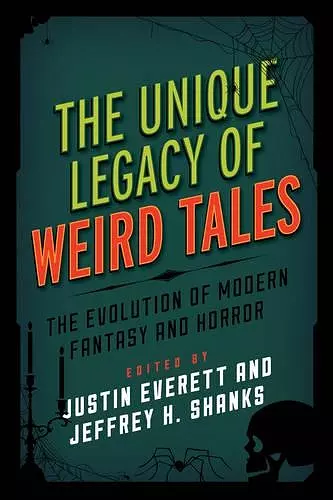The Unique Legacy of Weird Tales
The Evolution of Modern Fantasy and Horror
Justin Everett editor Jeffrey H Shanks editor
Format:Hardback
Publisher:Rowman & Littlefield
Published:1st Oct '15
Currently unavailable, and unfortunately no date known when it will be back

When the pulp magazine Weird Tales appeared on newsstands in 1923, it proved to be a pivotal moment in the evolution of speculative fiction. Living up to its nickname, “The Unique Magazine,” Weird Tales provided the first real venue for authors writing in the nascent genres of fantasy, horror, and science fiction. Weird fiction pioneers such as H. P. Lovecraft, Robert E. Howard, Clark Ashton Smith, Robert Bloch, Catherine L. Moore, and many others honed their craft in the pages of Weird Tales in the 1920s and 1930s, and their work had a tremendous influence on later generations of genre authors. In The Unique Legacy of Weird Tales: The Evolution of Modern Fantasy and Horror, Justin Everett and Jeffrey Shanks have assembled an impressive collection of essays that explore many of the themes critical to understanding the importance of the magazine. This multi-disciplinary collection from a wide array of scholars looks at how Weird Tales served as a locus of genre formation and literary discourse community. There are also chapters devoted to individual authors—including Lovecraft, Howard, and Bloch—and their particular contributions to the magazine. As the literary world was undergoing a revolution and mass-produced media began to dwarf high-brow literature in social significance, Weird Tales managed to straddle both worlds. This collection of essays explores the important role the magazine played in expanding the literary landscape at a very particular time and place in American culture. The Unique Legacy of Weird Tales will appeal to scholars and aficionados of fantasy, horror, and weird fiction and those interested in the early roots of these popular genres.
Everett and Shanks provide a challenging, provocative collection of essays on the legacy and importance of Weird Tales magazine, particularly from its inception in 1923 to the end of the 1930s, when other magazines (e.g., Unknown) stole some of its thunder by paying higher rates to authors for similar stories. The editors view the magazine as a discourse community—‘a unique and tightly knit community of editors, readers, illustrators, and writers,’ as they write in their introduction—and they place the magazine in relation (and opposition) to literary modernism at the height of its influence. H. P. Lovecraft and Robert E. Howard receive the lion’s share of attention (5 of the 14 essays treat their work at length), but other important writers are covered, including C. L. Moore, Clark Ashton Smith, and Robert Bloch. The little-known author Harold Lawlor, whose work was never collected in book form, receives much-needed attention from Sidney Sondergard, who plucks this writer’s reputation from obscurity. The letters column the magazine published is also taken seriously, with its swirling controversy over what ‘weird fiction’ actually meant. No bibliography, but extensive notes make up for that. Summing Up: Recommended. All readers. * CHOICE *
The Unique Legacy of Weird Tales . . . [is] a fascinating collection of essays. . . .This is a great volume for anyone who wants to understand why Weird Tales was so crucially important to the development of American fantasy, and the fan who’s just looking for recommendations on the best fantasy from the early Twentieth Century. * Black Gate *
This volume was faithfully strong throughout. . . .[This book] is very much worth it if you are interested in delving into critical secondary works about some of the greatest popular (pulp) fiction writers of the early to mid-20th century. I highly recommend it! * On an Underwood No. 5 *
The collection’s greatest collective strength is in the brilliant moments when individual contributors place Weird Tales in conversation with scholarship on American pulp magazines.... Unique Legacy as a whole offers an important meditation on the literariness of the pulps, their place in interwar modernism and periodical culture, and much on the significance of Lovecraft and Howard. * The Journal of the Fantastic in the Arts *
ISBN: 9781442256217
Dimensions: 237mm x 159mm x 25mm
Weight: 540g
266 pages